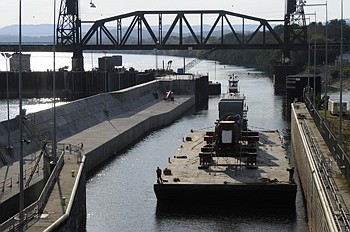The engines for a cleaner energy source in East Tennessee passed through the Chickamauga lock Wednesday.
But unless Congress provides a new funding source for the U.S. Army Corps of Engineers, such river shipments eventually could be forced to stop in Chattanooga.
On Wednesday, a barge carrying a 750,000-pound generator and a nearly 500,000-pound turbine moved upstream through the Chickamauga lock on the way to a new power plant TVA is building near Rogersville, Tenn. The $820 million combined-cycle, gas-fired plant, scheduled to open in 2012, will replace the John Sevier Fossil Plant - one of TVA's oldest and dirtiest coal plants.
"Without a navigable river, it would be much harder and expensive to transport this equipment," said Roger Waldrep, project manager for TVA's new gas plant.
But 318 miles of navigation upstream of Chattanooga are threatened by the continued decay of the existing Chickamauga lock and delays in completing a new and bigger lock at the Chickamauga Dam. Without aggressive maintenance, TVA may be forced to close the lock and shut off the upper third of the Tennessee River.
In the fiscal year that begins Friday, there is no more federal funding to continue the decade-old work on a new Chickamauga lock.
BY THE NUMBERS* $190 million: Amount spent to reroute roads, build a coffer dam and install a guidewall for the new lock* $634 million: Projected cost for the new and bigger lock and closure of the old lock at Chickamauga Dam* $3.7 million: Amount spent this year to shore up the existing 70-year-old lock* 1.5 million tons: Amount of cargo shipped through the Chickamauga lock in 2008* 4,000: Number of recreational boats that use the Chickamauga lock each year, the most of any lock on the Tennessee RiverSources: Tennessee Valley Authority, U.S. Army Corps of Engineers
Wayne Huddleston, the Corps of Engineers' project director for the new lock, said work is winding down on the coffer dam - a temporary dam to hold water out of the river bed while the new lock in built - below the Chickamauga Dam and construction will stop at the lock by year's end.
Other than some work on support beams and walls, the lock project will remain stalled until a new source of funding is provided by Congress.
"We have no authority or money at this point to move ahead with the new lock," Huddleston said. "So, not withstanding a funding fix, we may be looking at the coffer dam for a while."
After spending $190 million over the past decade to prepare the Tennessee River for a bigger lock at the Chickamauga Dam, the Corps has no more money to finish the new lock within the coffer dam. Huddleston estimates it likely will require another $444 million and five years to build the new lock, once work resumes.
In the meantime, the Corps is spending $1 million to $3 million a year to shore up the crumbling concrete in the existing lock, which has had concrete growth problems since it opened in 1940.
The funding problem stems from the high cost of finishing the Corps' Olmsted Dam on the Ohio River and the limited matching dollars coming into the Inland Water Users Trust fund, which is funded by barge fuel taxes.
The $1 billion Olmsted Dam project is expected to take another six years to complete and the barge fuel taxes are putting enough money in the trust fund to pay for other Corps construction projects.
U.S. Rep. Zach Wamp, R-Tenn., and other supporters of the new Chickamauga lock had hoped to change the funding formula to boost support for Corps projects like the Chickamauga Dam. But a planned rewrite of the Water Resources and Development Act stalled in this year's Congress.
Contact Dave Flessner at dflessner@timesfreepress.com or 423-757-6340.
Continue reading by following these links to related stories:
Article: New Chickamauga Lock needed
